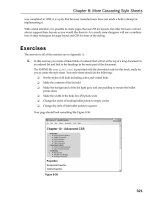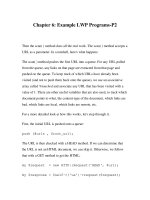Web Client Programming with Perl-Chapter 3: Learning HTTP- P3
Bạn đang xem bản rút gọn của tài liệu. Xem và tải ngay bản đầy đủ của tài liệu tại đây (76.23 KB, 27 trang )
Chapter 3: Learning HTTP- P3
HTTP Headers
Now we're ready for the meat of HTTP: the headers that clients and servers
can use to exchange information about the data, or about the software itself.
If the Web were just a matter of retrieving documents blindly, then HTTP
0.9 would have been sufficient for all our needs. But as it turns out, there's a
whole set of information we'd like to exchange in addition to the documents
themselves. A client might ask the server, "What kind of document are you
sending?" Or, "I already have an older copy of this document--do I need to
bother you for a new one?"
A server may want to know, "Who are you?" Or, "Who sent you here?" Or,
"How am I supposed to know you're allowed to be here?"
All this extra ("meta-") information is passed between the client and server
using HTTP headers. The headers are specified immediately after the initial
line of the transaction (which is used for the client request or server response
line). Any number of headers can be specified, followed by a blank line and
then the entity-body itself (if any).
HTTP makes a distinction between four different types of headers:
General headers indicate general information such as the date, or
whether the connection should be maintained. They are used by both
clients and servers.
Request headers are used only for client requests. They convey the
client's configuration and desired document format to the server.
Response headers are used only in server responses. They describe the
server's configuration and special information about the requested
URL.
Entity headers describe the document format of the data being sent
between client and server. Although Entity headers are most
commonly used by the server when returning a requested document,
they are also used by clients when using the POST or PUT methods.
Headers from all three categories may be specified in any order. Header
names are case-insensitive, so the Content-Type header is also
frequently written as Content-type.
In the remainder of this chapter, we'll list all the headers, and then discuss
the ones that are most interesting, in context. Appendix A contains a full
listing of headers, with examples for each and additional information on its
syntax and purpose when applicable.
General Headers
Cache-Control Specifies behavior for caching
Connection
Indicates whether network connection should close after
this connection
Date Specifies the current date
MIME-Version
Specifies the version of MIME used in the HTTP
transaction
Pragma Specifies directives to a proxy system
Transfer-Encoding
Indicates what type of transformation has been applied
to the message body for safe transfer
Upgrade Specifies the preferred communication protocols
Via
Used by gateways and proxies to indicate the protocols
and hosts that processed the transaction between client
and server
Request Headers
Accept Specifies media formats that the client can accept
Accept-Charset
Tells the server the types of character sets that the client
can handle
Accept-Encoding
Specifies the encoding schemes that the client can
accept, such as compress or gzip
Accept-Language
Specifies the language in which the client prefers the
data
Authorization Used to request restricted documents
Cookie Used to convey name=value pairs stored for the server
From
Indicates the email address of the user executing the
client
Host
Specifies the host and port number that the client
connected to. This header is required for all clients in
HTTP 1.1.
If-Modified-Since
Requests the document only if newer than the specified
date
If-Match
Requests the document only if it matches the given
entity tags
If-None-Match
Requests the document only if it does not match the
given entity tags
If-Range
Requests only the portion of the document that is
missing, if it has not been changed
If-Unmodified-
Since
Requests the document only if it has not been changed
since the given date
Max-Forwards
Limits the number of proxies or gateways that can
forward the request
Proxy-
Authorization
Used to identify client to a proxy requiring authorization
Range
Specifies only the specified partial portion of the
document
Referer
Specifies the URL of the document that contained the
link to this one (i.e., the previous document)
User-Agent Identifies the client program
Response Headers
Accept-Ranges
Declares whether or not the server accepts range
requests, and if so, what units
Age Indicates the age of the document in seconds
Proxy-
Authenticate
Declares the authentication scheme and realm for the
proxy
Public
Contains a comma-separated list of supported methods
other than those specified in HTTP/1.0
Retry-After
Specifies either the number of seconds or a date after
which the server becomes available again
Server Specifies the name and version number of the server
Set-Cookie
Defines a name=value pair to be associated with this
URL
Vary
Specifies that the document may vary according to the
value of the specified headers
Warning
Gives additional information about the response, for use
by caching proxies
WWW-
Authenticate
Specifies the authorization type and the realm of the
authorization
Entity Headers
Allow Lists valid methods that can be used with a URL
Content-Base Specifies the base URL for resolving relative URLs
Content-Encoding Specifies the encoding scheme used for the entity
Content-Language
Specifies the language used in the document being
returned
Content-Length Specifies the length of the entity
Content-Location
Contains the URL for the entity, when a document
might have several different locations
Content-MD5 Contains a MD5 digest of the data
Content-Range
When a partial document is being sent in response to a
Range header, specifies where the data should be
inserted
Content-Transfer-
Encoding
Identifies the transfer encoding used in the document
Content-Type Specifies the media type of the entity
Etag Gives an entity tag for the document
Expires Gives a date and time that the contents may change
Last-Modified Gives the date and time that the entity last changed
Location Specifies the location of a created or moved document
URI
A more generalized version of the Location header
So what do you do with all this? The remainder of the chapter discusses
many of the larger topics that are managed by HTTP headers.
Persistent Connections
As we touched on earlier, one of the big changes in HTTP 1.1 is that
persistent connections became the default. Persistent connections mean that
the network connection remains open during multiple transactions between
client and server. Under both HTTP 1.0 and 1.1, the Connection header
controls whether or not the network stays open; however, its use varies
according to the version of HTTP.
The Connection header indicates whether the network connection will be
maintained after the current transaction finishes. The close parameter
signifies that either the client or server wishes to end the connection (i.e.,
this is the last transaction). The keep-alive parameter signifies that the client
wishes to keep the connection open. Under HTTP 1.0, the default is to close
connections after each transaction, so the client must use the following
header in order to maintain the connection for an additional request:
Connection: Keep-Alive
Under HTTP 1.1, the default is to keep connections open until they are
explicitly closed. The Keep-Alive option is therefore unnecessary under
HTTP 1.1; however, clients must be sure to include the following header in
their last transaction:
Connection: Close
or the connection will remain open until the server times out. How long it
takes the server to time out depends on the server's configuration ... but
needless to say, it's more considerate to close the connection explicitly.
Media Types
One of the most important functions of headers is to make it possible for the
client to know what kind of data is being served, and thus be able to process
it appropriately. If the client didn't know that the data being sent is a GIF, it
wouldn't know how to render it on the screen. If it didn't know that some
other data was an audio snippet, it wouldn't know to call up an external
helper application. For negotiating different data types, HTTP incorporated
Internet Media Types, which look a lot like MIME types but are not exactly
MIME types. Appendix B gives a listing of media types used on the Web.
The way media types work is that the client tells the server which types it
can handle, using the Accept header. The server tries to return information
in a preferred media type, and declares the type of the data using the
Content-Type header.









